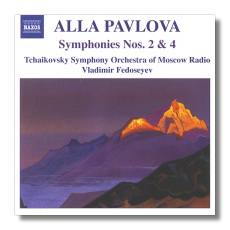
The Internet's Premier Classical Music Source
Related Links
- Latest Reviews
- More Reviews
-
By Composer
-
Collections
DVD & Blu-ray
Books
Concert Reviews
Articles/Interviews
Software
Audio
Search Amazon
Recommended Links
Site News
 CD Review
CD Review
Alla Pavlova

Symphonies #2 & 4
- Symphony #2 "For the New Millennium"
- Symphony #4
Tchaikovsky Symphony Orchestra of Moscow Radio/Vladimir Fedoseyev
Naxos 8.557566 DDD 57:33
I liked Naxos' 2004 release of Alla Pavlova's First and Third Symphonies (Naxos 8.557157), and I like this new release even better. Her music is not "difficult" and it is deeply communicative. Pavlova was born in Russia in 1952, and remained behind the Iron Curtain until 1990, when she came to New York. She is now a member of New York Women Composers, Inc.
The Second Symphony was written in 1997-98, and revised in 2002. (Apparently Pavlova revises her works with some frequency. The Third Symphony, as it was recorded by Naxos, already has been revised into a "more classical" work.) Its title is self-explanatory, but it is worth mentioning that Pavlova's later revision of the symphony was colored by her memory of the events of 9/11, one year earlier. This accounts for the now more tragic tone of the third movement. The symphony is in four movements; the outer movements are the longest, and contain important solos for violin. (On this recording, they are played by Yaroslav Krasnikov.) That Pavlova comes from Russia is almost instantly obvious, given the melancholy cast of her melodies. I mentioned "Doctor Zhivago" in my earlier review, and the same feeling persists here. In spite of the melancholy, and the sad anniversary which colors the third movement, one agrees with Pavlova when she writes, "The essence of the symphony in its entirety is the necessity of human striving toward Light and Love, no matter how tragic the reality is." Although the music is sad, it is not hopeless.
The Fourth Symphony was written in the spring and summer of 2002. It is in a single movement. Here, the organ plays an important role, right from the beginning. (It is played by Georgy Khachikyan.) Again, the very Russian-sounding music is very wistful but not despairing. Pavlova's inspiration for this work was the Buddhist concept of Shambala - in its most basic form, a place of peace and enlightenment. She refers to the Fourth Symphony as her "personal 'path to Shambala." The booklet cover reproduces a painting by Nicholas Roerich, also called "Path to Shambala," and she references this painting in her booklet notes. As with the Second Symphony, this music is tonal, simply constructed, and very melodic. Pavlova doesn't push into any new frontiers here, but these are not naïve works, and they should be very appealing to many listeners.
Conductor Fedoseyev has been around for a long time. So has the orchestra, although it used to be called the Moscow Radio Symphony Orchestra. The orchestra plays beautifully, so there's no need to hesitate on this account. The engineering team did their work beautifully too. The bass notes near the beginning of the Second Symphony have impressive impact, and the sound is warm and clear throughout.
Copyright © 2005, Raymond Tuttle




















